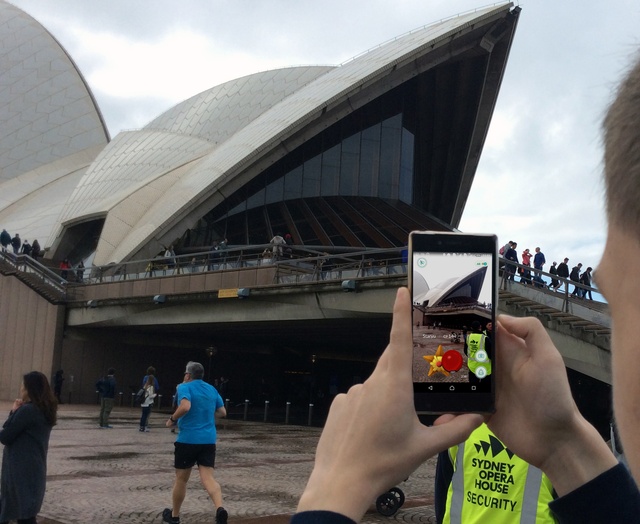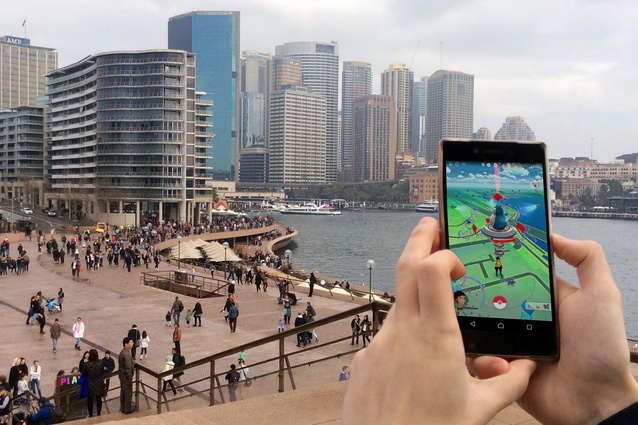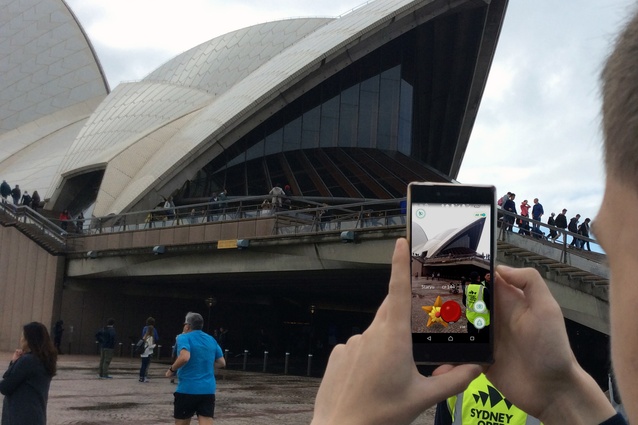Public space versus Pokémon Go
Computer games and the real world have collided through the lens of Pokémon Go. What lessons can this game, which layers virtual content over real-world locations, teach those charged with shaping public space in the real world? Rana Abboud, a Sydney-based architect whose research interests include new media and augmented reality, reports for ArchitectureAU.
Pokémon Go has reached fever pitch – some estimates reported that, within a week of its launch, the game had overtaken Twitter for the number of daily users in the USA. This smartphone-based game, which layers the virtual game world over real-world locations and challenges players to chase and catch different Pokémon characters, has become extraordinarily popular thanks in part to the nostalgia many players have for the 1990s game franchise.
Since its global launch in early July, the game has seen hoards of Pokémon trainers – those playing the game – out roaming the streets, smartphones in hand, in a quest to beat other trainers and “catch ‘em all.” The craze has seen public spaces in cities transformed into virtual battlegrounds, leading to a host of real-world interactions – good, bad and thought-provoking.
The good
It sounds oxymoronic, but the game is promoting physical exertion: Pokémon trainers are out exercising in their bid to catch virtual Pokémon. Thousands participated in Sydney’s first Pokémon Go tour of Circular Quay, sporting smartphones and sunscreen and walking several kilometres to visit Pokéstops and incubate PokéEggs. Mental health sufferers are praising the game’s ability to get them outside and interacting with others, while the game has become a social lubricant for many players by making them highly visible to one another as they cross paths in the real world.
The bad
Pokéstops and Pokégyms – in-game locations for collecting supplies and battling other trainers, often attached to real-life city landmarks – have seen some public spaces flooded with congregations of unwelcome gamers. This includes the recent water-bombings of players and subsequent police presence in the Sydney suburb of Rhodes, where three Pokéstops intersected in a residential neighbourhood. Flash mobs have appeared around sightings of rare Pokémon, alongside reports of real-world tagging at sites that double as virtual “battlegrounds” (“Go Team Valor!”). “Lures” – used within the game to attract Pokémon – have been appropriated by thieves to attract smartphone-wielding trainers, prompting police requests for vigilance.
The thought-provoking
Pokémon Go challenges urbanists to reframe public space in ways that address its potential for augmented experiences. Today’s understanding of public space is rooted firmly in the physical world, with legislation and institutions governing its design, function and permitted content. If 300 people were to descend on a public park, the council would traditionally be notified and asked to weigh in. But AR applications that appropriate public space can bypass such institutions. Pokémon Go stores its virtual content on servers far from the action, making the decisions that drive its gaming experience – and subsequent real-world implications – remotely. The game’s wild-fire adoption leaves proprietors of public spaces scrambling to clarify what rules should apply to the virtual content they now find co-located with their sites.
In the short weeks since its launch, the game’s augmented content has clashed with some sites’ real-world significance. At memorial grounds – from Ground Zero to public cemeteries and Auschwitz – the presence of Pokémon trainers hurtling Pokéballs at creatures seen only through the screens of their smartphones has offended the sites’ real-world custodians. While these institutions currently have no recourse to remove their locations from the game – its developers, Niantic, are only doing triage on locations deemed physically unsafe – the scenario raises important questions for the future. Who gets to define what virtual content can exist within and around a public space? And how will such decisions be made and enforced?
Pokémon Go also demonstrates how interest in a public space may be stoked by augmenting it with virtual content. This, in itself, is nothing new: AR artists and game designers, as well as those managing cultural heritage sites, have long used augmented content to attract and engage with their audience. But Pokémon Go has taken this audience from niche to mainstream. By anointing public spaces as hotspots within the game, Pokémon Go can drive foot traffic to points of interest. Players actively seek out Pokéstops and Pokégyms, discovering new places on account of their digital overlay, and engaging in AR tourism.
Unsurprisingly, entrepreneurs worldwide are jumping to monetize their proximity to in-game hotspots. Tongue-in-cheek real-estate ads now extoll their properties in Pokémon terms (“one-bedroom in share-house near two Pokégyms and three Pokéstops”). Savvy businesses are buying “lures” to increase foot traffic to their physical locations and drive sales. And while the locations of Pokéstops and Pokégyms are currently set by the game’s developers1, this will change as Niantic and Nintendo cash in on the lucrative promises of location-sponsored advertising.

Finally, Pokémon Go extends the concept of property ownership to its geo-located virtual turf. A physical public space that it designates a Pokégym – such as the Sydney Opera House – can “belong” in-game to one of three teams. Players must physically front up on-site to do virtual battle and “defend” their team’s territory. This mind-bending set-up has led to one amusing scenario in which the owner of a private residence in Massachusetts, USA was able to meet its Pokégym leader on his front doorstep. At a deeper level, allowing players to collectively “own” a site’s virtual territory drives affiliations with some physical locations – such as those Pokégyms held by a player’s own team – over others. The disruption here is that this is an affinity to place borne of ownership over content and actions that pertain to it in the virtual world.
Which gives those shaping public space in the real world something to think about.
1. Pokestops and Pokegyms are currently established using data originally crowd-sourced by players of Niantic’s previous mixed-reality game, Ingress.











